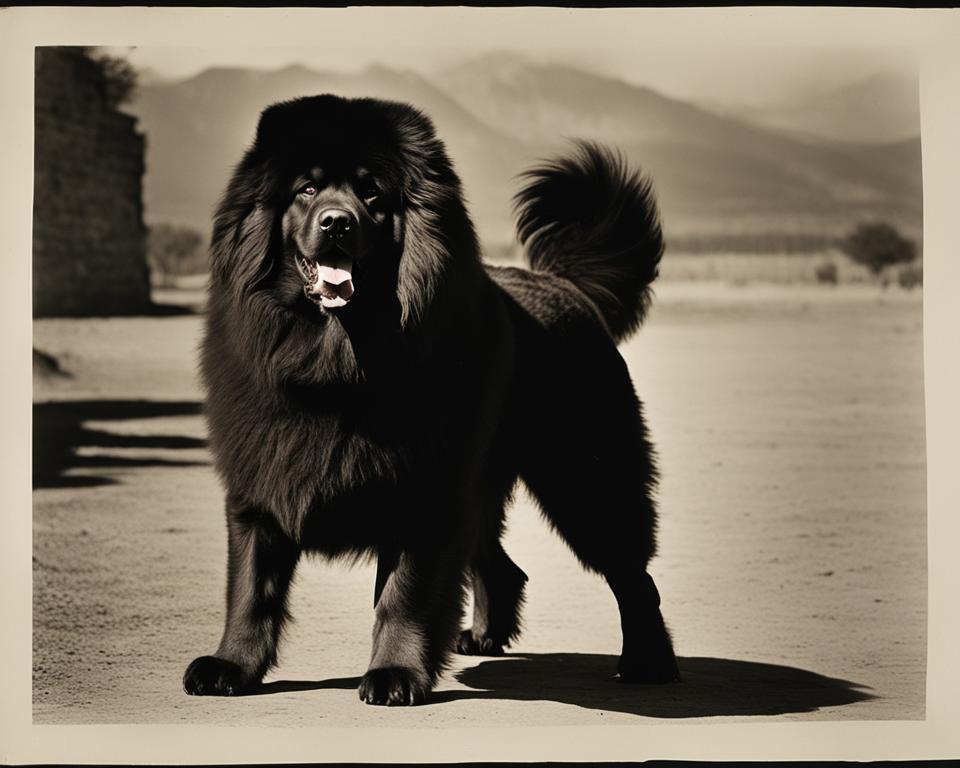Tibetan Mastiffs are majestic canines known for their imposing presence. However, training them can be a challenging experience. They are independent dogs that are not easily motivated by food treats. Starting training early is crucial, as older Tibetan Mastiffs can be more resistant to learning new commands. Patience and time are key when training this breed. It is important to avoid yelling and punishments, and instead use play, engagement, praise, and rewards. Tibetan Mastiffs may also have difficulty with reliable recall and can exhibit destructive behaviors when bored. Providing mental stimulation and a daily routine can help address these issues. Additionally, moderation in exercise and attention to their diet are necessary for maintaining their health. Proper socialization from a young age is also important to ensure they interact well with other dogs and humans.
Key Takeaways:
- Training Tibetan Mastiffs can be challenging due to their independent nature.
- Starting training early is crucial, as older Tibetan Mastiffs can be resistant to learning new commands.
- Patience, play, engagement, praise, and rewards are effective training methods for Tibetan Mastiffs.
- Providing mental stimulation, a daily routine, and moderation in exercise and diet are essential for their well-being.
- Proper socialization from a young age is important for Tibetan Mastiffs to interact well with other dogs and humans.
The History and Characteristics of Tibetan Mastiffs
Tibetan Mastiffs have a rich history and are believed to be one of the oldest and most ancient breeds of guardian dogs. They originated in the Himalayan region of Tibet and were bred by Tibetan nomadic tribes to guard livestock, monasteries, and homes from predators.
These dogs have a sturdy frame, with a thick double coat in various colors, making them adaptable to harsh mountainous climates. Their dense fur provides insulation from the cold and protection from extreme weather conditions.
With an imposing presence and regal appearance, Tibetan Mastiffs command attention wherever they go. They have a large head, expressive eyes, and a powerful build. Their strong and muscular bodies exude strength and confidence.
Temperamentally, Tibetan Mastiffs are watchful and alert. They are known for their aloof nature and a strong protective instinct towards their families. While they may appear reserved towards strangers, they form deep bonds with their owners and are fiercely loyal.
Tibetan Mastiffs are calm and mellow companions, but they do require moderate daily activity to keep them mentally and physically stimulated. They tend to be most active in cooler weather, enjoying their exercise outdoors.
It is important to provide Tibetan Mastiffs with regular exercise to prevent boredom and destructive behaviors. A daily routine that includes walks, playtime, and mentally stimulating activities will help keep them happy and content.
https://www.youtube.com/watch?v=uPdf8Z7qhxw
Key Characteristics of Tibetan Mastiffs:
- Origin: Himalayan region of Tibet
- Appearance: Sturdy frame, thick double coat, various colors
- Temperament: Watchful, aloof, protective, calm, and mellow
- Exercise Needs: Moderate daily activity, active in cooler weather
Understanding the history and characteristics of Tibetan Mastiffs provides valuable insights into their behavior and needs. By appreciating their origins and unique traits, owners can build a stronger bond with these majestic creatures.
Training Challenges Faced with Tibetan Mastiffs
Training Tibetan Mastiffs can be quite challenging due to their unique characteristics and independent nature. These dogs are known for their strong will and self-reliance, which can make them resistant to traditional training methods.
One of the primary training challenges with Tibetan Mastiffs is their independent nature. Unlike some other breeds that are eager to please their owners, Tibetan Mastiffs may not always see the point in obeying commands. This can make training sessions frustrating as they may question the need for certain behaviors or commands.
Additionally, aggression can be another issue that owners may face when training Tibetan Mastiffs. Without proper socialization and training, these dogs can exhibit aggressive behaviors towards strangers or other animals. It is important to address this behavior by implementing socialization techniques and seeking professional guidance if needed.
Leash training can also pose difficulties with Tibetan Mastiffs. These dogs are known for their strength and resistance, making it challenging to control them on a leash. Consistency, patience, and positive reinforcement techniques are key to successful leash training.
Excessive barking is another challenge that Tibetan Mastiff owners may encounter. These dogs have a tendency to bark, and if not properly trained, it can become a nuisance. Consistent training and positive reinforcement can help manage and decrease excessive barking.
Consistency in training is crucial when working with Tibetan Mastiffs. These dogs respond best to a consistent and structured approach. Training sessions should be regular and follow a routine to reinforce obedience and desired behaviors.
Positive reinforcement is a highly effective training approach for Tibetan Mastiffs. Using rewards such as treats, praise, and play can motivate them to learn and obey commands. This positive reinforcement technique creates a positive association with training and encourages them to repeat desired behaviors.
Training Challenges Faced with Tibetan Mastiffs – Summary:
Training challenges with Tibetan Mastiffs can be attributed to their independent nature, potential aggression, difficulties in leash training, excessive barking, the need for consistency, and the importance of positive reinforcement techniques.
To address these challenges effectively, it is essential to tailor training methods to suit the unique characteristics of Tibetan Mastiffs. With patience, consistency, professional guidance if needed, and the use of positive reinforcement, owners can overcome these challenges and establish a strong bond with their well-behaved Tibetan Mastiffs.

| Training Challenges Faced with Tibetan Mastiffs | Solutions |
|---|---|
| Independent Nature | Implement consistent training methods and positive reinforcement. |
| Aggression | Focus on socialization techniques and seek professional guidance if needed. |
| Leash Training | Use patience, consistency, and positive reinforcement techniques. Consider using front-clip harnesses or head halters. |
| Excessive Barking | Create a consistent training routine and address barking behavior through positive reinforcement. |
| Consistency | Follow a structured training schedule and reinforce obedience consistently. |
| Positive Reinforcement | Use treats, praise, and play as rewards to motivate and reinforce desired behaviors. |
Tips for Training Tibetan Mastiffs
When it comes to training Tibetan Mastiffs, addressing their independent nature is key to achieving success. These intelligent and strong-willed dogs require patience, consistency, and positive reinforcement techniques. Here are some tips to help you effectively train your Tibetan Mastiff:
Independence in Training Tibetan Mastiffs
Tibetan Mastiffs are known for their independent nature, which can make them less motivated by traditional training methods. To overcome this challenge, focus on using positive reinforcement techniques. Use treats, praise, and play as rewards to motivate your Tibetan Mastiff during training sessions. This will help to reinforce desired behaviors and encourage your dog to stay engaged and cooperative.
Addressing Protective Instincts in Tibetan Mastiffs
Tibetan Mastiffs have a strong instinct to protect, which can manifest as aggression if not properly managed. Early socialization is crucial to help your Tibetan Mastiff become comfortable and confident in various situations. Controlled exposure to new environments, people, and animals can help address their protective instincts and prevent aggressive behavior.
Managing Barking in Tibetan Mastiffs
Tibetan Mastiffs are known to be vocal dogs and excessive barking can be a common issue. To manage this behavior, it is important to train the “quiet” command. Use positive reinforcement techniques to reward your Tibetan Mastiff for being quiet and provide mental and physical stimulation to prevent boredom, which can contribute to excessive barking.
Leash Training Techniques for Tibetan Mastiffs
Leash training can be challenging with Tibetan Mastiffs due to their size and strength. Patience is key when leash training these powerful dogs. Consider using a front-clip harness or head halter to provide better control and prevent pulling. Reward calm behavior and gradually increase the duration and distance of walks to ensure a successful leash training experience.
Consistency in Training Tibetan Mastiffs
Consistency is essential when training Tibetan Mastiffs. Establish a consistent routine and use the same commands every time you train your dog. This will help your Tibetan Mastiff understand what is expected of them and reinforce good behavior. Avoid inconsistent or conflicting commands, as this can confuse your dog and hinder the training process.
Positive Reinforcement for Tibetan Mastiffs
Positive reinforcement is the most effective training method for Tibetan Mastiffs. Rewarding desired behaviors with treats, praise, and play will motivate your dog to continue performing those actions. Avoid punishment or harsh training methods, as they can lead to fear and aggression. Focus on building a strong bond with your Tibetan Mastiff through positive and rewarding training sessions.
By addressing the independent nature, protective instincts, excessive barking, leash training, consistency, and using positive reinforcement techniques, you can ensure a successful training experience with your Tibetan Mastiff. Remember to be patient, consistent, and always prioritize the well-being and happiness of your dog.
Effective Communication and Building a Bond with Tibetan Mastiffs
Understanding the body language of Tibetan Mastiffs is crucial for effective communication. By paying attention to their subtle cues and expressions, you can better understand their emotions and intentions. This understanding allows you to communicate with them in a way that they can easily comprehend, fostering a stronger bond between you and your furry companion.
Building a bond with Tibetan Mastiffs involves earning their trust and respect. These dogs are loyal and protective by nature, and they appreciate a confident and consistent leader. To build this bond, it is essential to establish yourself as the alpha and set clear boundaries and expectations. Positive reinforcement techniques, such as rewards and praise, can be highly effective in encouraging desired behaviors and fostering a strong bond.
Understanding Body Language
Tibetan Mastiffs communicate through various body language signals, and being able to interpret them accurately is essential for effective communication. Pay attention to their tail position, ear position, facial expressions, and overall body posture to gauge their mood and level of comfort. For example:
- A relaxed tail held at a natural height indicates a calm and content state.
- A tail tucked between the hind legs suggests fear or anxiety.
- Pricked ears facing forward indicate attentiveness and interest.
- Yawning or lip licking may indicate stress or discomfort.
- A stiff or lowered body posture can signal aggression or submission.

By observing and understanding these subtle cues, you can respond and communicate with your Tibetan Mastiff in a way that puts them at ease and strengthens your bond.
Obedience Training
Obedience training plays a vital role in building a strong bond with your Tibetan Mastiff. Teaching them basic commands like “sit,” “stay,” “come,” and “heel” not only enhances their obedience but also allows for better communication between you and your canine companion.
When training, use positive reinforcement techniques, such as treats and praise, to motivate and reward your Tibetan Mastiff for following commands. Be patient and consistent, as these dogs thrive on routine and clear expectations. Use voice commands along with hand gestures to reinforce the verbal cues, helping them understand and respond to your instructions.
Troubleshooting Behavioral Problems
In some cases, Tibetan Mastiffs may exhibit behavioral problems that require troubleshooting. Aggression is one such issue that may arise, especially if they feel threatened or protective. It is essential to address aggression promptly to ensure the safety of both your Mastiff and others. In such cases, seeking professional guidance from a dog behaviorist or trainer experienced in handling mastiffs can be beneficial.
Other common behavioral problems, such as excessive barking or destructive chewing, can be managed through proper training and addressing any underlying causes, such as boredom or anxiety. Engaging your Tibetan Mastiff in mentally stimulating activities and providing plenty of physical exercise can help alleviate these issues.
Building a Strong Bond
Building a bond with Tibetan Mastiffs is a gradual process that requires patience, consistency, and understanding. Spend quality time bonding and engaging in activities that your Mastiff enjoys, such as walks, playtime, or training sessions. Show them love, affection, and respect, and they will reciprocate with unwavering loyalty and companionship.
Tips for Effective Communication and Bonding
| Tip | Description |
|---|---|
| 1 | Learn and understand Tibetan Mastiffs’ body language to communicate effectively. |
| 2 | Establish yourself as a confident and consistent leader to build trust and respect. |
| 3 | Use positive reinforcement techniques during obedience training to reinforce desired behaviors. |
| 4 | Seek professional help when dealing with aggression or severe behavioral issues. |
| 5 | Spend quality time bonding with your Tibetan Mastiff through enjoyable activities. |
Resources for Training Tibetan Mastiffs
When it comes to training your Tibetan Mastiff, having access to the right resources can make a world of difference. Fortunately, there are several options available to help you navigate the unique challenges of training this majestic breed.
One option is to enroll in dog training courses specifically designed for Tibetan Mastiffs. Organizations like the International School for Certified Dog Trainers (ISCDT) offer comprehensive courses that cover various aspects of dog training, including specific guidance for Tibetan Mastiffs. These courses provide you with valuable knowledge and techniques to effectively train and communicate with your canine companion.
Another resource to consider is working with professional dog trainers who have experience in training Tibetan Mastiffs. These experts understand the breed’s temperament, needs, and potential challenges. They can provide personalized guidance, address specific issues, and help you establish a strong bond with your Tibetan Mastiff.
Comprehensive guides and books dedicated to Tibetan Mastiff training are also invaluable resources. One such example is the “Tibetan Mastiff 101: Owner’s Guide,” a comprehensive guide that offers practical tips, training techniques, and insights into the breed’s behavior. These resources can serve as a reliable reference throughout your training journey, offering valuable advice and addressing common concerns.
By leveraging these resources – whether through dog training courses, professional trainers, or comprehensive guides – you can gain the knowledge and support needed to overcome training challenges and ensure the success of your Tibetan Mastiff’s training regimen.
FAQ
What are some common training challenges with Tibetan Mastiffs?
Tibetan Mastiffs have an independent nature, making them difficult to train. They may also exhibit aggression if not properly socialized. Leash training and excessive barking can also be challenges.
How can I overcome the challenges of training a Tibetan Mastiff?
Using positive reinforcement techniques, being patient and consistent, and addressing their protective instincts through socialization can help overcome training challenges with Tibetan Mastiffs.
What tips can you provide for training Tibetan Mastiffs?
It is important to address their independent nature, manage their protective instincts, and provide mental and physical stimulation. Consistency in training methods and positive reinforcement techniques are also effective.
How can I effectively communicate and build a bond with my Tibetan Mastiff during training?
Understanding their body language, using positive reinforcement, and practicing obedience training with voice commands, hand gestures, and well-timed rewards can help with effective communication and bonding.
What resources are available for training Tibetan Mastiffs?
Dog training courses such as those offered by ISCDT, professional dog trainers experienced in working with Tibetan Mastiffs, and comprehensive guides specifically tailored to this breed can provide valuable resources for training Tibetan Mastiffs.

Leave a Reply